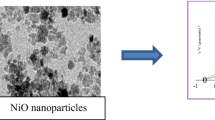Abstract
The aim of this study was to examine the effects of nickel oxide nanoparticles on the activity and thermal stability of lysozyme obtained from Rutilus frisii kutum. The synthesis of the nanoparticles was performed by the chemical co-precipitation method. To evaluate the synthesis process, X-ray diffraction, scanning electron microscope, and Fourier transform infrared spectroscopy were evaluated. The size of the nanoparticles was in the range of 20–30 nm with a spherical morphology and gray–black color. To determine thermal stability, the fraction unfolded curve and ΔG° as a function of lysozyme temperature in the absence and presence of the nanoparticles were obtained. With respect to Tm at ΔG° = 0, we obtained Tm of lysozyme from 314 K in the absence of the nanoparticles to 332 K in the presence of 0.0001 g/cm3 nickel oxide nanoparticles. Therefore, thermal stability of lysozyme was increased with the rise of nanoparticles’ concentrations. The reversible unfolding as a result of heating lysozyme was observed at Tm = 318 K. Kinetic parameters, Km and Vmax, of the enzyme were also determined from 0.007 g/cm3 and 172 units/min in the absence of the nanoparticles to 0.005 g/cm3 and 104.166 units/min in the presence of 0.0001 g/cm3 nickel oxide nanoparticles, respectively. The emission intensity of lysozyme decreased in the presence of the nanoparticles, while its absorption intensity increased without any shift at 340 and 280 nm, respectively. Consequently, the nickel oxide nanoparticles can interact with lysozyme that results in decreasing its enzymatic activity due to changes in its active site.
Graphical abstract






Similar content being viewed by others
References
Simonet BM, Valcárcel M (2009) Anal Bioanal Chem 393:17
Raghupathi KR, Koodali RT, Manna AC (2011) Langmuir 27:4020
Salata OV (2004) J Nanobiotechnol 2:2
Cheng YH, Lai CM, Lin KS, Wang SS (2017) Colloids Surf B 151:344
Roco MC (2005) Environ Sci Technol 39:5
Taghavi SM, Momenpour M, Azarian M, Ahmadian M, Souri F, Taghavi SA, Sadeghain M, Karchani M (2013) Electron Physician 5:706
Aillon KL, Xie Y, El-Gendy N, Berkland CJ, Forrest ML (2010) Adv Drug Deliv 61:457
Zhu Y, Zhao Q, Li Y, Cai X, Li W (2006) J Nanosci Nanotechnol 6:1357
Templeton RC, Ferguson PL, Washburn KM, Scrivens WA, Chandler GT (2006) Environ Sci Technol 40:7387
Saurabh S, Sahoo PK (2008) Aquacult Res 39:223
Callewaert L, Michiels CW (2010) J Biosci 35:127
Momeni L, Shareghi B, Saboury AA (2017) J Biomol Struct Dyn 35:1381
Lee S, Hwang SH, Jeong J, Han Y, Kim SH, Lee DK, Lee HS, Chung ST, Jeong J, Roh C, Huh YS, Cho WS (2016) Part Fibre Toxicol 13:30
Capasso L, Camatini M, Gualtieri M (2014) Toxicol Lett 226:28
Duan WX, He MD, Mao L, Qian FH, Li YM, Pi HF, Liu C, Zhou Z (2015) Toxicol Appl Pharmacol 286:80
Sudha N, Yousuf S, Israel EVMV, Paulraj MS, Dhanaraj P (2016) Colloids Surf B 141:423
Natesan S, Sowrirajan C, Yousuf S, Enoch IV (2015) Carbohydr Polym 115:589
Chandrasekaran S, Sudha N, Premnath D, Enoch IV (2015) J Biomol Struct Dyn 33:1945
Sudha N, Israel VM (2015) J Solut Chem 44:1367
Hu X, Yu Z, Liu R (2013) Spectrochim Acta A 108:50
Vignesh G, Manojkumar Y, Sugumar K, Arunachalam S (2015) J Lumin 157:297
Wu L, Ma B, Sheng Y, Wang W (2008) J Mol Struct 891:167
Liu Y, Liu R (2012) Food Chem Toxicol 50:3298
Shang W, Nuffer JH, Muñiz-Papandrea VA, Colón W, Siegel RW, Dordick JS (2009) Small 5:470
Chakraborti S, Chatterjee T, Joshi P, Poddar A, Bhattacharyya B, Singh SP, Chakrabarti P (2010) Langmuir 26:3506
Chakraborti S, Sarwar S, Chakrabarti P (2013) J Phys Chem 11:13397
Dijk EV, Hoogeveen A, Abeln S (2015) PLoS Comput Biol 11:1004277
Eisenthal R, Danson MJ, Hough DW (2007) Trends Biotechnol 25:247
Acknowledgements
Financial support of this study under the Grant no. 134396/KM by the Caspian Sea Basin Research Center of Guilan is gratefully acknowledged. The authors would like to offer special thanks to research deputy of the University of Guilan.
Author information
Authors and Affiliations
Corresponding author
Electronic supplementary material
Below is the link to the electronic supplementary material.
Rights and permissions
About this article
Cite this article
Tolouei-Nia, B., Aghamaali, M.R., Asoodeh, A. et al. Activity and stability of lysozyme obtained from Rutilus frisii kutum in the presence of nickel oxide nanoparticles. Monatsh Chem 150, 363–369 (2019). https://doi.org/10.1007/s00706-018-2323-7
Received:
Accepted:
Published:
Issue Date:
DOI: https://doi.org/10.1007/s00706-018-2323-7




